Fairchild-Republic A-10/OA-10 Thunderbolt II
Role: Close Air Support (CAS), Forward Air Control (FAC)
Builder: Fairchild-Republic
Variants: A-10A, OA-10A, A-10C
Nickname: Warthog
Operators: USAF
The A-10 and OA-10 Thunderbolt IIs are the first US Air Force aircraft specially designed for close air support of ground forces. They are simple, effective and survivable twin-engine jet aircraft that can be used against all ground targets, including tanks and other armored vehicles. The primary mission of the A-10 is to provide day and night close air combat support for friendly land forces and to act as forward air controller (OA-10) to coordinate and direct friendly air forces in support of land forces. The A-10 has a secondary mission of supporting search and rescue and Special Forces operations. It also possesses a limited capability to perform certain types of interdiction. All of these missions may take place in a high or low threat environment.
The A/OA-10 aircraft was specifically developed as a close air support aircraft with reliability and maintainability as major design considerations. The A-10 is slow enough to be an observation plane. This greatly increases the A-10's effectiveness at protecting ground troops.
The A-10's survivability in the close air support arena greatly exceeds that of previous Air Force aircraft. The A-10 is designed to survive even the most disastrous damage and finish the mission by landing on an unimproved airfield. Specific survivability features include titanium armor plated cockpit, redundant flight control system separated by fuel tanks, manual reversion mode for flight controls, foam filled fuel tanks, ballistic foam void fillers, and a redundant primary structure providing “get home” capability after being hit.
All of the A-10's glass is bulletproof and the cockpit itself is surrounded by a heavy tub of titanium. Titanium armor protects both the pilot and critical areas of the flight control system. This titanium "bathtub" can survive direct hits from armor-piercing and high explosive projectiles up to 37 mm in size. The front windscreen can withstand up to a 23 mm projectile. Fire retardant foam protects the fuel cells which are also self sealing in the event of puncture.
The General Electric Aircraft Armament Subsystem (30 millimeter Gun System) is located in the forward nose section of the fuselage. The gun system consists of the 30 mm Gatling gun mechanism, double-ended link-less ammunition feed, storage assembly and hydraulic drive system. The General Electric GAU-8/A 30 mm seven barrel cannon, specifically designed for the A-10, provides unmatched tank killing capability. The gun fires armor-piercing projectiles capable of penetrating heavy armor. It also fires a high explosive incendiary round, which is extremely effective against soft skinned targets like trucks. The cannon fires at a rate of 4,200 rounds per minute. The A-10's maneuverability, teamed with the gun's accuracy, allows the pilot quick reaction with lethal effects. Other weapons include the AGM-65 Maverick and AIM-9 Sidewinder missiles.
Avionics equipment includes communications, inertial navigation systems, computer-aided fire control and weapons delivery systems, electronic countermeasures, target penetration aids and self-protection systems. The A-10 employs both electronic and infrared countermeasures against enemy weapons systems. The weapons delivery system incorporates a heads-up display that provides the pilot with references for flight control and weapons employment. The weapons delivery systems include head-up displays that indicate airspeed, altitude and dive angle on the windscreen, a low altitude safety and targeting enhancement system (LASTE) which provides constantly computing impact point freefall ordnance delivery; and Pave Penny laser-tracking pods under the fuselage.
The A-10/OA-10 have excellent maneuverability at low air speeds and altitude, and are highly accurate weapons-delivery platforms. The A-10 has half the turning radius of the US Air Force's other primary CAS aircraft, the F-16. After initially leaving a target, the A-10 can turn around and hit the same target again, all in around 7 seconds. Due to its large combat radius, the Thunderbolt II can loiter for extended periods of time, allowing for the coordination required to employ within yards of friendly forces. They can operate under 1,000-foot ceilings (300 meters) with 1.5-mile (2.4 kilometers) visibility. Using night vision goggles, A-10/ OA-10 pilots can conduct their missions during darkness. The A-10s highly accurate weapons delivery system makes it effective against all ground targets including tanks and other armored vehicles.
The aircraft is capable of worldwide deployment and operation from austere bases with minimal support equipment. Their short takeoff and landing capability permit operations in and out of locations near front lines. In addition to its survivability, the A-10 has the ability to land on unimproved airfields and be flown and maintained near Army ground troops. Highly effective and efficient in combat, the A-10 is capable of sustaining operations on unimproved airfields near ground troops -- keys to success in conducting small operations against hostile forces. The A-10's rapid re-fueling and re-arming capability allows it to operate from forward bases close to the front lines. It is also capable of refueling in the air.
Author: Marc Eichler
A-10 Precision Engagement Program (PEP)
In 2000 preparations for the Precision Engagement Program (PEP) upgrade
program began. PEP will give the A-10 the capability of deploying
precision-guided weapons and will enhance its combat effectiveness.
The upgrade is carried out in two phases, called Spiral One and Spiral Two.
Spiral One will improve target acquisition, battlefield situational awareness,
weapon employement and minimize overall pilot workload. In March 2004 trial
installation work of Spiral One began. Incorporating the following modifications:
- New glass cockpit
- Mew weapons storage management system
- Integration of JDAM and WCMD weapons
- Incorporation of the AN/AAQ-28 Litening targeting pod and
several variants of the Sniper pod
- increase in electrical power capacity
- integration work in preparation for a digital datalink system
Spiral Two will include the following upgrades:
- Incorporation of the Joint Tactical Radio System set
- Incorporation of a digital datalink system.
- Enhanced position locating reporting system
When upgraded under PEP the aircraft is designated A-10C. Between July
and October 2004 the first A-10C underwent ground and instrumentation
tests prior to the first flight in November 2004.
The first operational squadrons receiveed the A-10C in the summer of 2006.
The entire active-duty A-10 fleet received the PEP upgrade. The last
aircraft was due to be modified before the summer of 2009.
Author: Webmaster. Source: Air Forces Monthly, January 2005, p. 34-35
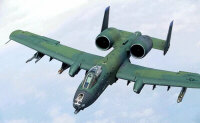
A-10 in old green camoflage
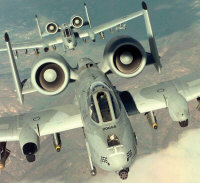
A/OA-10s in grey-white camoflage
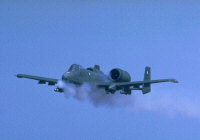
A-10 firing its 30mm cannon
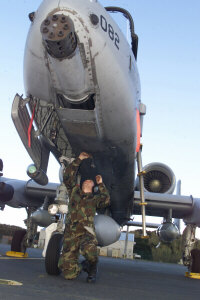
30mm GUA-8/A seven barrel cannon
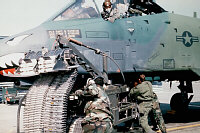
Rapid re-arming of the GUA-8/A
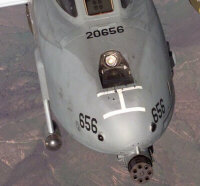
Airborne refuelling capability
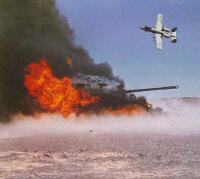
Tank destroyed by the A-10

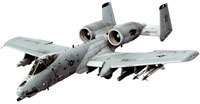
 Back to Index
Back to Index